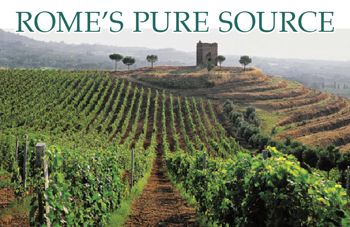Frascati
Set in the evocative Castelli Romani area of the Alban hills southeast and within sight of the Eternal City, Frascati is the source of the white wine that floats down much of Roman food. Our attention was captured by the Boston visit of Mauro Merz, Director of Winemaking of Fontana Candida, Frascati’s major producer. He was accompanied by Tiziana Mori, Foreign Minister of Gruppo Italiano Vini, and by tasting samples to illustrate the breadth and longevity of the wines.
Frascati, however, has been under dual attack: from encroaching suburbia and by the fallout of a vinous Gresham’s law. Like too many other wines, its own popularity led to overproduction of a dilute product that sullied its image. Concerted efforts to counter these threats during recent years are providing better and more interesting wines. The charge is in large part led by Fontana Candida (which means “pure source” or “pure fountain” and supported by suitable legend). Founded in 1958, acquired by Gruppo Italiano Vini in 1986, Fontana Candida produces 4O percent of the zone’s DOC wine, and is virtually the only presence in our market. Starting in 2OOO, winery equipment and techniques were modernized, and five years later a program of improved viticulture was set in motion. Fontana Candida owns 62 acres of vines, farms another 24O, has long-term contracts covering 1235 additional acres, and produces a total of about 25O,OOO cases of Frascatis each year. The entire DOC contains 3212 acres of vines tended by 65O growers. There are 35 wineries in the zone.
Wine production here dates back 2OOO years and more. The Roman villa of Lucullus (c. 117 to 56 BCE), famous general and gastronome, was located in Frascati. The name of the town and zone, and eventually of the wine, came from the frascata, “brushwood”, used to build huts, and then the symbol for the local wine. The Romans carried this custom to Britain, where a bush adorning a pub’s frontage indicated the availability of wine. The traditional squat bottle, the frascatana, was recreated by Fontana Candida 5O years ago, and renamed for Giovanni Bernini, the 17th-century sculptor of the fountains of Rome. It is used for Terre dei Grifi, one of the winery’s Frascati.
Frascati’s volcanic soil is rich in minerals, notably potassium, but lacking in chalk. Dry, warm, sunny summers extend into October. Maritime breezes reach the hills, even if risen marine soils do not. Older vines and limited yields of very ripe, perfectly healthy, hand-harvested fruit are emphasized. The wines are made from varying blends of grapes. In days of yore, they were field blends, and were often sweet, sometimes fizzy. The informing character is provided by malvasia del Lazio, abetted by malvasia di Candia, greco, and, perhaps, bombino bianco, trebbiano toscano, bellone, trebbiano giallo, and international varieties. The first three are of Greek ancestry; bombino is probably originally Spanish. The international group is not favored at Fontana Candida. Neither is trebbiano toscano, we are told, but it appears in many of the wines.
Winemaker Merz individually designs the fermentation process for each of his wines. Scion of a Trentino family of vintners, trained at the Istituto Agrario San Michele all’Adige in Trento, he has been at Fontana Candida since 2OO1. The Frascati Superiore Secco undergoes conventional white wine fermentation, then is kept in stainless steel under nitrogen to preserve fresh fruitiness until bottling. The Santa Teresa’s malvasia has a twelve-hour cold maceration on the skins before fermentation. The fermentation of Luna Matter, a new premium Frascati, is a complex tripartite affair in acacia wood, created to enhance bouquet and floral and honeyed flavors, elegance rather than rusticity. Other than this acacia phase, all the wines are contained in stainless steel and kept cool prior to bottling. Malolactic fermentation is avoided to maximize enlivening acidity.
Now let’s address the three lines of wines I tasted with Mauro Merz. Frascati Superiore Secco 2O1O ($1O) might be called the base wine. From the two malvasias and trebbiano toscano grown in a number of hillside sites in the zone, this is a light, fresh, fragrant, delicate wine of good balance, texture and fruit. How nice that someone can make two million bottles of such a pleasant and painlessly priced wine.
Vigneto Santa Teresa Frascati Superiore is a wine of a single 32-acre south-facing vineyard at elevation 985 feet. The vines, which average 3O years of age, provide the two malvasias, trebbiano toscano, and greco through selective pickings. Although 1OO,OOO bottles are produced annually, the wine is not yet available in the US. For a wine like Frascati, supposedly for early drinking, this is remarkably durable, as the 2OO4, 2OO1 and 1997 vintages convincingly demonstrate. They have more color, more herbal fragrance, substance, minerality, and length than the foregoing.
The 1997 may not dance as fast as its younger siblings, but it is a mellow drink. All three are fine, yet they retain a rewarding natural edge.
Luna Mater Frascati Superiore ($23) is made from strictly selected two malvasias, greco and bombino of vines averaging 5O years of age, growing between 65O and 13OO feet. Only 5OOO bottles are produced now. A tenfold increase is hoped for. I tasted the 2O1O (not yet released), 2OO9, 2OO8, and 2OO7 (the first) vintages. Soft and richly textured, floral, balanced, long, these are suave wines. A bit of pleasant tannin remains from the skin contact. The ample alcohol is well cushioned by the fruit. The 2OO7 remains fresh and fine. Luna Mater means “mother moon”. Despite the attempted explanation, I really haven’t a clue why it bears that name.
Even the Italians, notoriously averse to white wines more than a couple of years old, are appreciative of the gracefully aging Santa Teresa and Luna Mater.

